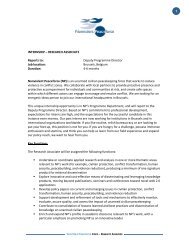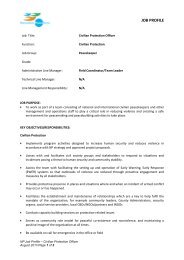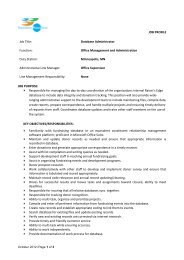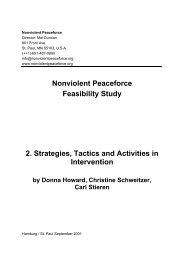Rumors of Peace - Issue 3 2006 - Nonviolent Peaceforce
Rumors of Peace - Issue 3 2006 - Nonviolent Peaceforce
Rumors of Peace - Issue 3 2006 - Nonviolent Peaceforce
You also want an ePaper? Increase the reach of your titles
YUMPU automatically turns print PDFs into web optimized ePapers that Google loves.
<strong>Rumors</strong> <strong>of</strong> <strong>Peace</strong><br />
PAGE Volume VI, <strong>Issue</strong> 3 ◆ <strong>2006</strong><br />
Youth Conference Connects By Maya Main<br />
This summer, I interned with the <strong>Nonviolent</strong> <strong>Peace</strong>force as a Youth<br />
Organizer, preparing NP’s 2nd annual Youth Conference on Nonviolence.<br />
Thirteen participants from North Minneapolis and St. Cloud,<br />
ages 14-22, represented a wide range <strong>of</strong> cultures and ethnicities, with<br />
all <strong>of</strong> the students being people <strong>of</strong><br />
color. The conference focused on<br />
personalizing the concept <strong>of</strong> nonviolence<br />
into our everyday lives,<br />
from how we communicate with<br />
each other to how we resolve conflicts.<br />
The weekend was extremely<br />
powerful and very telling. It was<br />
also a great opportunity for NP<br />
to create relationships with urban<br />
youth. While our organisation<br />
focuses on international conflict,<br />
it is important to interact with our<br />
neighbors, young people in particular,<br />
as many <strong>of</strong> them experience<br />
conflict on a daily basis.<br />
One <strong>of</strong> the most significant things the facilitators did this weekend<br />
was listen and empathize with the experiences <strong>of</strong> the participants.<br />
We did not tell the youth how they should live nonviolently because<br />
we recognized the drastic differences <strong>of</strong> our varied experiences and<br />
backgrounds. Because you cannot force someone to be nonviolent, the<br />
curriculum for the conference allowed the participants to decide for<br />
themselves how they could effectively apply the tools we learned. We<br />
role-played conflicts that we were currently experiencing. I encouraged<br />
the participants to think outside the box but also to challenge<br />
the applicability and feasibility <strong>of</strong> the tools and scenarios presented<br />
to them. Self-directed change, I<br />
believe, is the most powerful and<br />
sustaining type <strong>of</strong> change. Having<br />
made a connection with the North<br />
Minneapolis and Saint Cloud communities,<br />
we must now focus our<br />
training curricula on empowering<br />
youth to use their own stories and<br />
assist them in identifying how nonviolence<br />
can be useful in their lives.<br />
I can confidently say that each<br />
participant, including myself, walked<br />
away on Sunday morning having<br />
changed in his or her own unique<br />
way. Recently, I met with the director<br />
Urban youth at NP sponsored conference.<br />
<strong>of</strong> the North Minneapolis organisation<br />
where some <strong>of</strong> the youths were from. I briefed him on the conference<br />
and discussed next steps. He showed me an article that one <strong>of</strong><br />
the female participants had written: she wrote about how she was now<br />
evaluating different situations where she could respond nonviolently<br />
and prevent conflicts from escalating into violence. Hearing this, even<br />
from just one participant, made me feel that we had been successful.<br />
<strong>Nonviolent</strong> <strong>Peace</strong>force Training for Trainers Gathering in Thailand<br />
Ten Days in July—Building<br />
for the Future<br />
by Jan Passion<br />
<strong>Nonviolent</strong> <strong>Peace</strong>force plans to<br />
increase our capacity so that NP could mobilize<br />
hundreds or even thousands <strong>of</strong> trained<br />
peace workers to a conflict situation. To this<br />
end, NP held our first Training for Trainers<br />
in Thailand in July—bringing together 26<br />
peace trainers from 19 different countries<br />
and all <strong>of</strong> the inhabited continents, with a<br />
wealth <strong>of</strong> experience from many different<br />
conflict zones.<br />
NP is now ready to provide the essential<br />
“Core Training” to large numbers <strong>of</strong> field<br />
staff in multiple languages and to <strong>of</strong>fer<br />
multiple Core Trainings at the same time.<br />
This is a critical step in NP’s development<br />
and our plan to grow exponentially and thus<br />
increase our impact in the field <strong>of</strong> nonviolent<br />
intervention.<br />
Working to build on NP’s experience<br />
on the ground, the training included two<br />
members from NP’s Sri Lanka Project and<br />
five previous leaders <strong>of</strong> NP’s Core Trainings.<br />
Striving to learn from similar third party<br />
nonviolent intervention organisations, two<br />
trainers from <strong>Peace</strong> Brigades International<br />
also attended.<br />
For ten days we learned about NP, shared<br />
our diverse experiences, talked about the<br />
skills needed for Field Team Members for<br />
NP and practiced the delivery <strong>of</strong> various<br />
activities. We created and participated in<br />
role plays, deepened our own practice and<br />
understanding <strong>of</strong> nonviolence, improved<br />
our intercultural communication skills and<br />
talked about the dynamics and challenges<br />
<strong>of</strong> working in intercultural teams in conflict<br />
zones. For a half-day, we participated in a<br />
simulation <strong>of</strong> life in a war zone and <strong>of</strong> how<br />
field staff work to protect civilian lives in<br />
such situations, building strong training<br />
teams and preparing ourselves to be able<br />
to deliver solid, successful Core Trainings<br />
for NP.<br />
The group included roughly equal numbers<br />
<strong>of</strong> women and men and people from the<br />
global south and the global north. The age<br />
range was from 27 through 65. The years<br />
and wealth <strong>of</strong> experience found in this group<br />
<strong>of</strong> trainers was most inspiring—a gathering<br />
<strong>of</strong> teachers, NGO workers, activists, trainers,<br />
and field workers with a passionate commitment<br />
to nonviolence, justice and peace.<br />
Together we are building viable alternatives<br />
to war.<br />
Nonviolence trainers at the opening <strong>of</strong> the<br />
Training <strong>of</strong> Trainers. Photo by Jan Passion.












